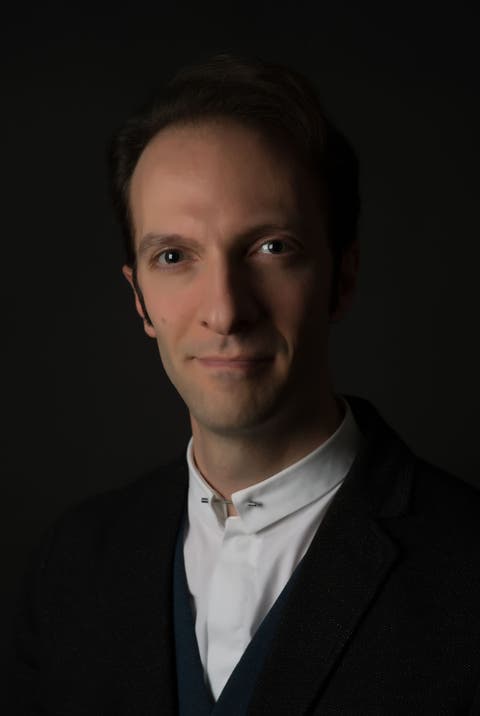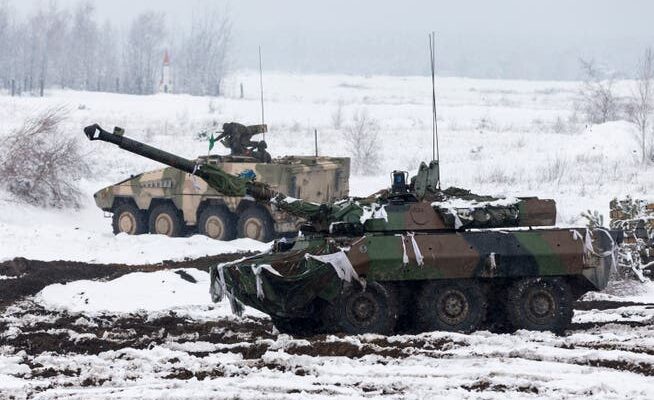France has pushed ahead of its partners with its announcement that it will supply reconnaissance tanks to Ukraine. Why being first was important to Emmanuel Macron.
Wheels instead of caterpillars: The AMX-10 RC (front) during a Franco-German military exercise in winter 2013.
Since the beginning of the war, Emmanuel Macron has been on the phone with his Ukrainian colleague Volodymyr Zelensky at least once a month. As a rule, hardly anything is known about the content of the conversations – and if so, then usually only days or weeks later. On Wednesday, however, this was different. The Élysée Palace announced in the early evening that Macron Selenski had promised to deliver armored vehicles on the same day. Shortly thereafter, the President’s entourage confirmed that it was the AMX-10 RC reconnaissance tank. The French army owns around 250 of them.
It is not yet clear how many of these France will leave to the Ukrainians and when they will be deployed. But the announcement had it all. The offensive communication about arms deliveries to Ukraine alone is unusual in Paris, since the French had not disclosed any details about their arms deliveries for a long time. Macron’s offensive got others moving too. Less than 24 hours later, Berlin and Washington followed the French and promised Kyiv further military support in the form of up to 90 Bradley and Marder infantry fighting vehicles and a Patriot anti-aircraft system. The British defense secretary also indicated that tank deliveries would be considered. Although discussions about the delivery of this material were already underway in various constellations, the French obviously surprised their partners with their timing.
Correction of the image
Pierre Haroche sees the choice of timing as a matter of diplomatic calculation. With his announcement, Macron relied on a leadership position on this issue, which obviously worked, says the expert on European integration and security policy, who teaches at Queen Mary University in London. This is important for France insofar as it allows the negative image that has emerged from Macron’s policies in recent months to be corrected: through the ongoing talks with Moscow, for example, or the statement that Russia should not be humiliated.
In addition, there is persistent criticism that France, with the largest army in continental Europe, has so far left relatively few weapons to Ukraine. Doubts have been raised not only in Eastern Europe about how seriously Macron meant his declarations of solidarity with Zelensky. Macron can now claim that his decision to supply these armored vehicles has caused other countries to follow suit.
For France, the delivery of AMX-10 RC involves limited risk. The scout tanks, developed in the 1970s, have been in use since 1981. They are currently being phased out and will gradually be replaced by a modern model, the EBRC Jaguar developed in France. “The French army will not miss you,” says Haroche. In doing so, Macron avoids domestic criticism from those who repeatedly warn that France’s army is being weakened by military aid to Ukraine. In fact, the President’s announcement on Wednesday made little political headway.

Even if certain experts praised the mobility and the not inconsiderable striking power of these reconnaissance tanks, nobody in France assumes that they will have a decisive influence on the course of the war. However, Haroche sees a certain symbolism in the delivery: the AMX-10 RC can be used quickly and offensively. The message to all those who thought that the fronts were deadlocked and that the new realities had to be accepted is this: they believe that the Ukrainians can regain territory.
However, the promises made by the three western countries do not directly fulfill the wishes of the Ukrainians. They hope for main battle tanks – primarily the German Leopard 2, the American M1 Abrams or the French Leclerc. Apparently, French Defense Minister Sébastien Lecornu initially ruled out the delivery of Leclerc tanks during his visit to Kyiv shortly before the turn of the year. He gave similar reasons as those put forward in the case of the Leopard 2: the maintenance and operation of the tank are complicated. In addition, it is sometimes argued in France that you need the approximately 200 remaining tanks yourself.
Heavy tanks within the realm of possibility
Haroche, already in September in an opinion piece had pleaded for the delivery of around 50 Leclerc tanks, these arguments are not convincing. “There aren’t many scenarios where France can use these tanks, you don’t need them in the Sahel or the Middle East. They are made for land defense in Europe.”
The argument of maintenance and service is perhaps more credible. But if you leave them to the Ukrainians, you learn a lot about their operational capability in a high-intensity war. The tank could even be improved, says Haroche. France has stopped producing the Leclerc in order to one day replace it with the Franco-German model. The stalled project has recently got going again, but the new model should not be operational until 2040 at the earliest. Until then, the manufacture and delivery could be interesting for the French defense industry – also with regard to new customers, says Haroche.
The doctrine, which determines what material can be provided to the Ukrainians as “absolutely necessary,” has proved very dynamic since the beginning of the war, says Haroche. It is therefore conceivable for him that the Ukrainians will one day also be given heavy tanks. However, Haroche regrets that analysis in the West always leads to the same conclusion: that it would have been better for the course of the war if more powerful material could have been found earlier.
